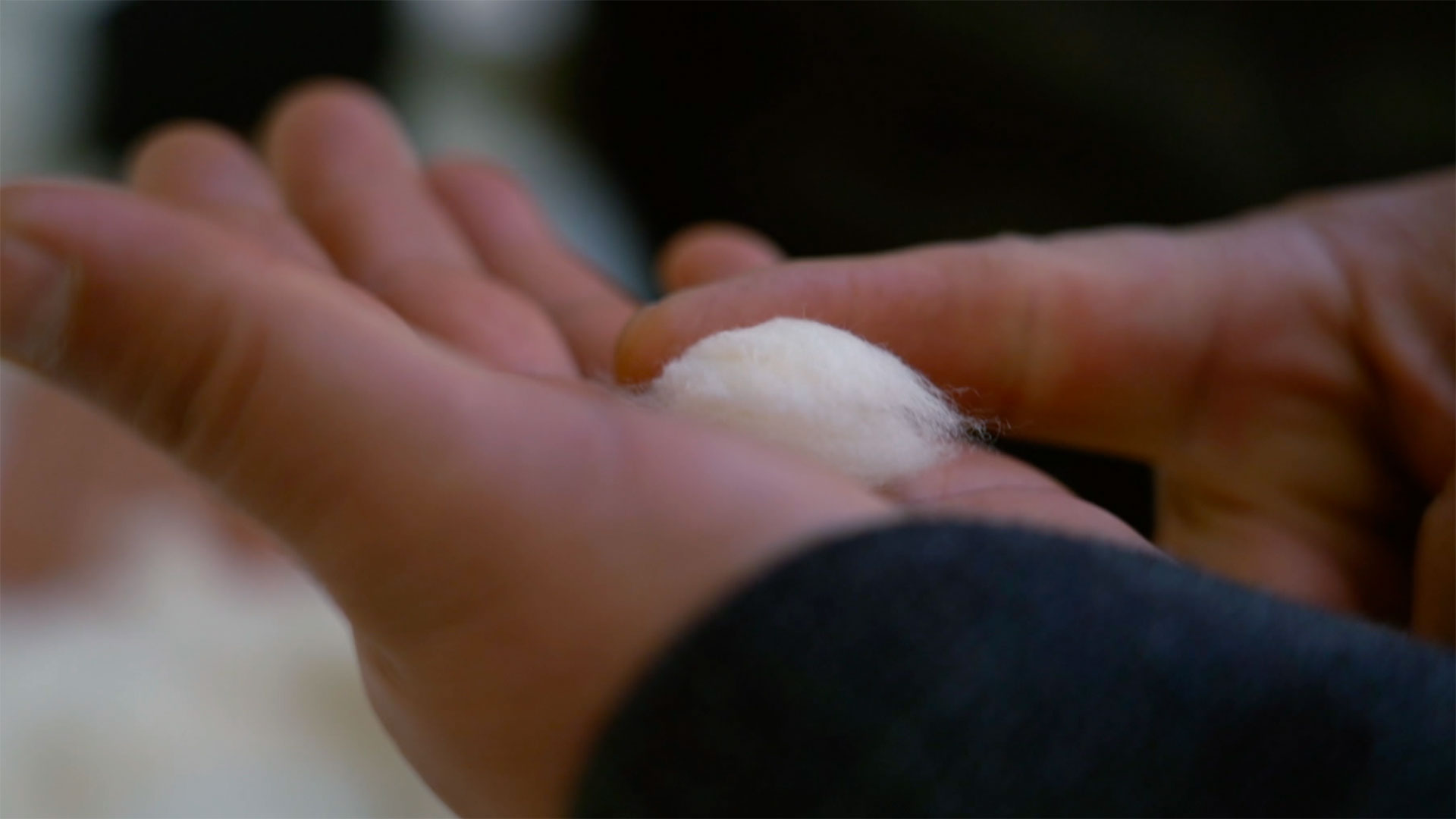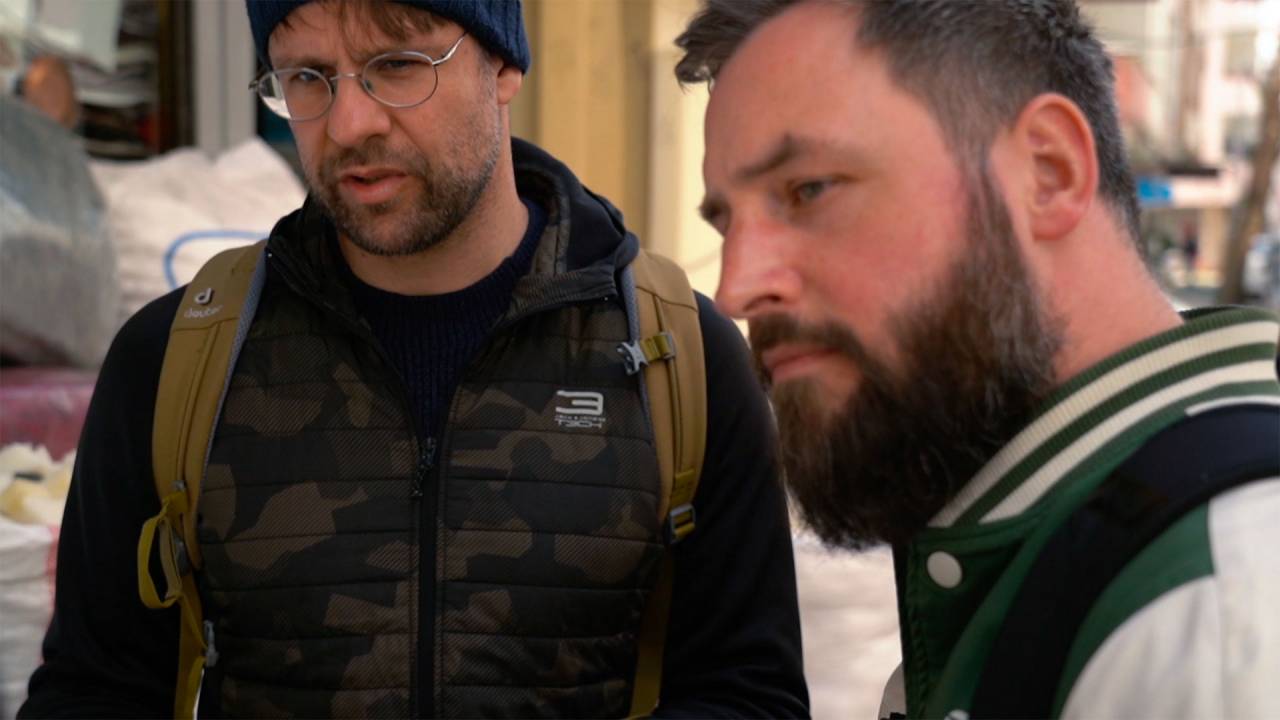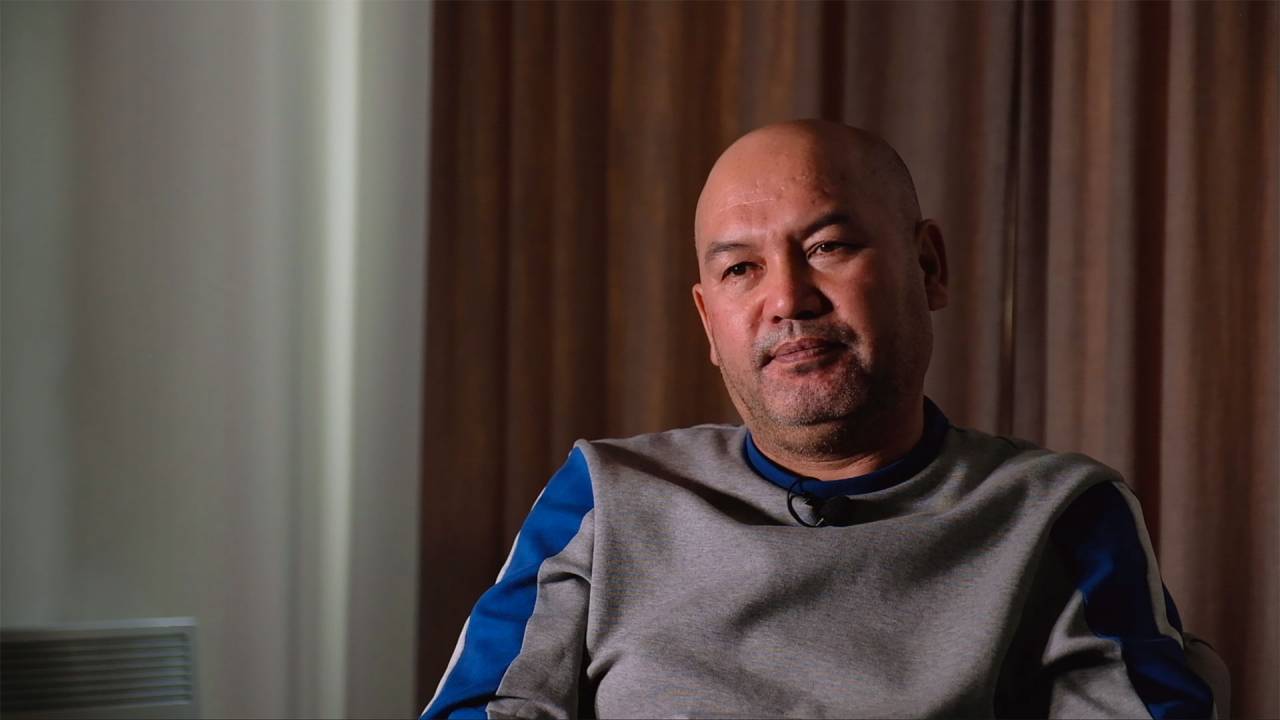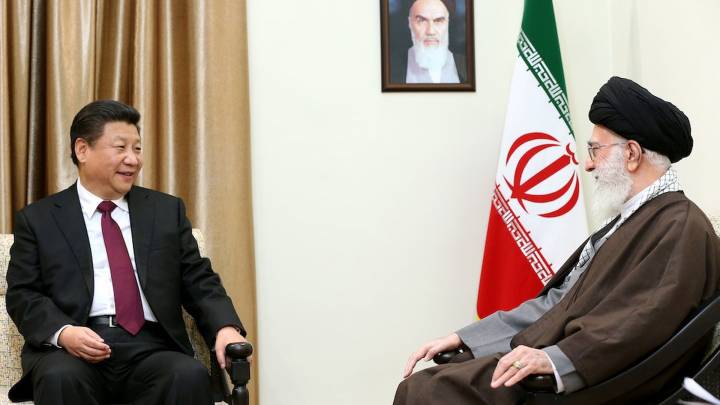Is there cotton from forced labor in clothing of German fashion brands? From the plantations and factories in the Chinese region of Xinjiang leads a trail to the warehouses of large companies such as Adidas and Hugo Boss.
This report was awarded the Deutscher Reporter:innen-Preis and was nominated for the Deutscher Journalistenpreis as well as the Deutscher Menschenrechts-Filmpreis. The research was conducted in cooperation with STRG_F (NDR / funk). Find the film here. The following article was translated from German – the original report was published on May 5, 2022.
More than 5,000 kilometers and nine time zones separate the fashion shops of Berlin and Hamburg from the Chinese region of Xinjiang. And yet these places are connected: in northwest China high-quality cotton is grown, harvested and processed. And as this research shows the yarn spun from it is apparently found in clothing from German fashion brands: Adidas, Hugo Boss, Puma, Jack Wolfskin and Tom Tailor.
This itself would not be a problem, were it not for the suspicion that the cotton from Xinjiang is obtained through forced labor. In this Chinese region, President Xi Jinping’s government has over the years created an industrial system of oppression consisting of labor camps and prisons. In particular, members of Muslim minorities toil for the Chinese economic miracle. Uyghurs, Kazakhs, Kyrgyz and others who, in Beijing's view, endanger the unity of the People's Republic. In Xinjiang, they apparently want to re-educate them – and exploit them economically in the process.
Because of these accusations, the U.S. has made it illegal to import cotton products from Xinjiang since January 2021. German companies such as Hugo Boss, Adidas and Puma had assured at the time that they would not source cotton from this region – or that they would not do so in the future. But how credible are such claims since one-fifth of the cotton produced worldwide comes from Xinjiang?
This report is the result of months of research. A journey, step by step along a red thread that links plantations in Xinjiang to stores in German city centers. It takes us to a laboratory in Jülich in the Lower Rhine region and to Manchester, Istanbul and other places that cannot be named. Chemical analyses, bills of lading, cotton smuggled in a carpet and footage from the Sentinel-2 satellite will play a role.
We met people who have been victims of forced labor in the fields and factories of Xinjiang, and one who knows the system from the inside. He says that he himself used to kidnap and torture people and now, like his victims, lives in fear of the Chinese security apparatus. And we talk to a person who has been working in China for decades and is convinced that anyone who does business there cannot rule out the possibility that they are profiting from oppression.
High quality cotton must be harvested by hand - and that takes many hands
Eyüp Enwer* lives in a suburb of Istanbul, the glittering shopping street Istiklal and the Blue Mosque are far away, the store signs are partly labeled in Arabic. To understand how the cotton industry in Xinjiang works, one has to talk to someone like him. The Uyghur grew up in southern Xinjiang and used to run a small cotton farm. At the same time, he was in charge of purchasing cotton for a large cooperative.
A few years ago, Enwer fled China, for his protection we will not disclose the exact date nor his name. His old life was all about cotton and his hands show it till today. During our visit he passes the display of a Turkish store, he reaches into one of the large sacks of cotton. His hands divide and pluck the fibers, lay them out on the back of his hand to check the quality.
Enwer knows not only how to determine the quality of cotton but also how hard the work is in the field. "Harvesting for eight to ten hours is exhausting. You can't sit and spend the whole day bent over. Your back hurts and on top of that it's up to 30 degrees." He describes a drudgery to which the Chinese government has conscripted more and more young Uyghurs in Xinjiang since the early 2000s.
Enwer says officials justified the measure at the time by citing high unemployment among young men. However, the wages on the large plantations in northern Xinjiang were low and in some cases were even offset against the rations. Those who refused were threatened with prison. "In 2014, I witnessed 175 people being taken to labor camps because they wanted to take care of their own fields instead of those from strangers," Enwer recalls. In the end, he says, they were sentenced to prison terms ranging from five to 18 years.
"For the highest quality, cotton has to be harvested by hand, which is the main reason for the forced labor," Enwer says. Besides, he says, the fields are now so large that there are not enough workers in many growing areas. The former cotton farmer is convinced that "the authorities force people from other areas to harvest.” A development that has accelerated once again since 2010, he says.
China is unimpressed by such reports. According to the government, there cannot be forced labor in cotton fields because most of the harvest is done by machines. Most recently, state television reported that more than 85 percent of field work was mechanized. The report is accompanied by aerial images of harvesters rolling over the seemingly endless plantations of the Tarim Basin.
A detailed analysis of satellite data, on the other hand, suggests that the Chinese government's figures are embellished. Together with analysts from the company Vertical 52, we examined the entire cultivation area of Xinjiang for this research. An area four times larger than Germany. The analysis was based on images taken by the Sentinel-2 satellite, which also regularly flies over Xinjiang on behalf of the European Space Agency.
The first step was to determine exactly where cotton is grown in Xinjiang. The key to this came from visual clues during sowing last spring. The results were cross-checked with statistical data from official Chinese government yearbooks. This was followed by analysis of the patterns by which fields changed color during the fall harvest. A rapid change from white cotton to brown soil is indicative of machine harvesting A slow thinning, in contrast, indicates laborious harvesting by hand.
The result: according to our analysis, slightly more than one-third of cotton in Xinjiang was harvested by hand in 2021. Significantly more than the Chinese government claims. "We surveyed 2.7 million hectares, just over 900,000 of which were harvested by hand," says Marcus Pfeil of Vertical 52, summarizing the analysis. "That's pretty much equivalent to what Turkey and Australia harvest together." Both countries are themselves among the world's top ten producers of cotton.
The share of hand harvesting is particularly high where most Uyghurs live: in southern Xinjiang around the major city of Kashgar. According to satellite analysis, approximately 96 percent of the cotton there is picked by hand. This is also controversial because almost all of China's long-fiber cotton – which is considered to be of extremely high quality and is therefore exported – grows in this area.
But does this cotton end up in products made by German fashion brands? And if so, how can it be proven?
We find answers to these questions in an inconspicuous building in the industrial area of Jülich. Agroisolab is located between the new building of an expanding pharmaceutical giant and the Institute for Solar Research. Its director, Dr. Markus Boner, is a specialist in the analysis of isotopes and knows: "Nature leaves a signature in cotton, a kind of fingerprint."
Cotton consists of chemical elements such as water and carbon. Elements that exist in different forms, the isotopes. Their respective mass can be determined and thus Agroisolab can calculate an isotopic fingerprint that varies from region to region. Eventually samples of the same origin can be assigned to each other. That is the theory at least.
It is unclear, however, whether this method also works in processed textiles. Last spring, Agroisolab, together with WWF and the Niederrhein University of Applied Sciences, planned an experiment to answer this question.
The goal of the experiment is to test how the massive use of chemicals in textile production affects the isotope profile. As clothing is supposed to feel and look good, the natural product is treated extensively, for example with bleach and dyes.
But to identify cotton from Xinjiang, Agroisolab must first determine the isotopic fingerprint of this cotton – however samples from China are not yet part of the study "Textile Tracker." The search for this cotton is a challenge that takes us to Rune Steenberg's living room in Berlin Neukölln – and to his new carpet.
Steenberg is an anthropologist and has been researching on Xinjiang for years. He has lived in the region, speaks Uyghur and Mandarin. He advises us on this research and helps with expertise and translations. Today we are with him because a long-awaited package has arrived from China. "A friend of mine was in Xinjiang and that's when I asked her if she could get cotton."
Yes, she could. A white plastic bag with cotton is hidden inside a hand-knotted carpet. It was bought in the large city of Kashgar, i.e. in the region where, according to satellite analysis, harvesting is almost exclusively done by hand. The probability of forced labor is therefore particularly high.
Later we receive further samples – among others from a source in Hong Kong. It came with documents proving that this cotton was sold by the 123rd Regiment of the Seventh Division of the Bingtuan. This paramilitary organization is responsible for parts of the administration in Xinjiang on behalf of the Chinese government and is considered a pillar of state repression.
In the laboratory of Agroisolab in Jülich, it becomes clear shortly thereafter that all our samples have a similar isotope signature, which differs significantly from that of other cotton, for example from Turkey, India or even other regions of China. Cotton from Xinjiang thus has a fingerprint, and now we know what it looks like.
Eleven hours a day at the sewing machine
Erbaqyt Otarbai has experienced firsthand how forced labor can take place in Xinjiang. The ethnic Kazakh lives in Manchester, UK, with asylum status. The 46-year-old family man was interned in Chinese camps and prisons for months. He says he was restrained, beaten and tortured. Scars on his wrists, ankles, head and back bear witness to his story. "Once they took me into the shower and used electric lasers on me," he recalls.
Growing up in Xinjiang, Erbaqyt and his family later moved to nearby Kazakhstan. When he wanted to visit his sick father in Xinjiang in 2017, police officers took away his passport at the border, brought him to interrogation and analyzed his cell phone with the help of a computer. "Why did you move to Kazakhstan? Do you go to the mosque? Do you pray?" The policemen ask harsh questions, but in the end, they let him go.
Shortly afterwards, Erbaqyt is arrested again. This time the interrogation is conducted more harshly. "In the police station there was an iron chair, they call it the tiger chair. I had to sit in it, then they clamped my arms and legs," Erbaqyt reports. "They said there were problems with my thinking and that they found WhatsApp on my phone." The messaging service is banned, the police officers explain. And they have him taken to prison.
There he had to share a cell with 22 other prisoners. Cameras monitored the room, the toilet was a bucket in the corner. He had to wear hand- and foot-shackles for 98 days. Later he was taken to a labor camp – and had to sew in an affiliated textile factory. "If I had refused, they would have taken me back to prison,” says Erbaqyt with certainty. In the weeks that followed, he had to sit at the sewing machine for eleven hours a day.
And he recalls another detail: the guards made sure that the prisoners did not see which brands they had to sew clothes for.
Reports like Erbaqyt's suggest that forced labor is widespread not only on cotton plantations but also in factories. For a long time, these were mainly so-called re-education camps. According to Xinjiang expert Steenberg, many of these camps have since been dissolved. At the same time, however, a veritable prison industry has sprung up. "These are prisons and companies that work with these prisons to get cheap labor," he says.
Steenberg also cites official Chinese government documents. Since 2017, he says, more and more people have been sentenced to prison, an increase of several hundred percent in some cases. “Those affected are probably many members of ethnic minorities, who are then also forced to work.”
Even prison wards allegedly make a cut
An insider explains to us how the system is set up. We are able to speak with a former police officer from China who worked in Xinjiang and later fled. We will call the whistleblower Wang Leizhang. He has had a career in the Chinese security apparatus for decades and supports his story with private documents, photographs and copies of official records.
Wang's exile is a small room somewhere in Europe. His old life is piled up in just a few square meters. Uniforms he brought back from Xinjiang hang in a veneer closet. A dozen military boots lie in the corner. On the windowsill, Wang has placed a pair of binoculars. He is convinced the Chinese secret service is hunting him. He rarely leaves his apartment. Wang says he drinks to forget – but still he remembers.
"We were told who was going to be arrested," Wang says. "Then we intercepted the person at the front door, jumped on him and pushed him to the ground." Anyone who resisted was beaten, he says. "We pulled the suspects' pants down to their knees and took away their shoes so they couldn't escape."
The real ordeal begins in the interrogation. "Anyone who falls asleep is beaten. After three days without sleep or water, they confess everything," Wang says. The more tired the arrestees, the easier it was for police officers to trick them and extract confessions. "We could just claim anything and they would confirm it."
Wang is also familiar with the tiger chair, which was already reported by Erbaqyt. It's an iron contraption in which people are restrained. Forced into an unnatural position, the pain increases by the hour. Wang has also tortured people in this way. Those who do not confess are threatened with more violence. "Some beat with sticks, others whip prisoners with cables because they find beating with sticks too tiring."
And Wang confirms another detail from Erbaqyt's account: clothes are sewn in labor camps. "During my time in Xinjiang, a large number of Uyghurs were taken to camps," the former policeman recalls. "They were supposed to be re-educated through labor, such as sewing." But forced labor exists not only in the camps, he said, but also in the prisons.
"In all Chinese prisons, detainees are forced to work. The operators can make so much money, so they offer the labor of prisoners to companies," Wang tells us. "If the government requires detainees to sew five hours a day, the director of the prison will slap five more hours on top and collect the extra profit," Wang reports.
From Xinjiang to German clothing stores
Back to Jülich. By the beginning of November 2021, the scientists of the "Textile Tracker" are sure: the origin of cotton can be detected in processed clothing. But which clothing are most likely to contain cotton from Xinjiang?
Trade databases provide clues. Developed for market analysis by companies, they offer insight into the engine room of globalization. Millions of bills of lading, customs documents and shipping connections can be accessed here for a fee. Thus begins a weeks-long search for connections between Chinese textile manufacturers and companies in Germany. They serve as an indication of which garments are worth an isotope analysis.
And we find what we are looking for. According to the bill of lading, a blouse sold by Hugo Boss in Germany is produced by a Chinese textile manufacturer that has already been linked to forced labor. A T-shirt sold by Adidas in Germany is shipped by a Vietnamese company that is part of a Chinese enterprise. A shirt offered by Jack Wolfskin on its German web store is sewn by an Indonesian company that sources large quantities of fabric from China – and from a company that has also already been named in the context of forced labor.
We order the T-shirts, the blouse and a total of 22 other clothing articles. Several packages of clothing are sent to Agroisolab in Jülich for further examination. A few weeks later, we receive the results: according to this analysis, cotton from Xinjiang was apparently detected in products from Adidas, Puma, Hugo Boss, Jack Wolfskin and Tom Tailor.
When asked by Norddeutscher Rundfunk (NDR), the manufacturers stood by their claim that they do not source cotton from Xinjiang. Adidas stated in writing that it only sources cotton from other countries. Puma stated, "Based on all the information we have gathered and traceability and controls we have established, we can say that no cotton from Xinjiang is used in our products."
Hugo Boss said it does not tolerate forced labor in its supply chains and would not comment further on whether it can exclude that it uses cotton from Xinjiang in its products. Jack Wolfskin did not comment specifically on the question of cotton from Xinjiang but stressed that forced labor was unacceptable and that all suppliers were aware that "available supply chain data and certificates are provided." Tom Tailor did not respond to our questions.
"Xinjiang is increasingly sealed off"
One thing is clear: not all cotton in Xinjiang is harvested or processed by people in forced labor. But this research shows how integral forced labor is to the system of oppression used by the Chinese government against minorities. Our final interview partner sheds light on the circumstances companies are getting themselves into, if they produce in China, specifically in Xinjiang.
Our source is an auditor for Western companies and fears not only for his own business but also for the safety of his Chinese employees – and must therefore remain anonymous. For decades he has been auditing supplier companies around the world, including some in countries with particularly difficult political conditions. But the situation in Xinjiang is especially dicey.
"Since the accusations about the Uyghurs became louder, Xinjiang has been increasingly sealed off and work has become more difficult," he reports. Such is the critical nature of the situation, he says, that Chinese colleagues are afraid to go about their work. "We know that the intelligence service visits our employees in their houses or apartments. Those who want to find out about working conditions can end up in prison themselves."
Meanwhile, the Chinese government would require that each audit for forced labor be approved separately - and often such approval would not be granted. In recent years, auditors have nevertheless found evidence of forced labor. On one occasion they discovered that the owner of factory they were auditing also owned the local prison. In another case, the factory workers presented to the auditors turned out to be laymen – apparently to conceal who was really sewing there.
Given these conditions, can Western companies really rule out the possibility of forced labor in their supply chains? The auditor is skeptical. "Theoretically, it's possible, but highly unlikely. They would have to prove such a claim, and right now no one can. The Chinese government simply doesn't allow such audits."
* Name changed









